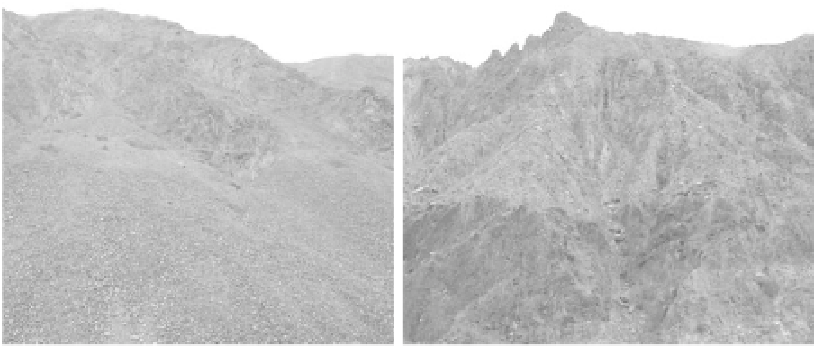Environmental Engineering Reference
In-Depth Information
(a) (b)
Fig. 2.15
Grain erosion occurs on the south-facing bank (a) while rill erosion (water erosion) occurs on the north-facing
bank (b) of a small stream (See color figure at the end of this topic)
A surface layer of bare rocks was broken down into grains due to sun exposure and temperature
change. Over time a certain thickness of the surface layer of the rocks has been broken down into grains.
Wind detached the grains from the rock and triggered grain flow. The amount and size of grains removed
by wind is a function of wind speed. An experiment was done to study the relation of the amount and
size of grains blown down with wind speed. Because grain erosion occurs at quite high elevations or on
dangerous cliffs in the earthquake area, the experiment was done in the Xiaojiang River basin where
grain erosion occurs on relatively small mountains. The lithology at the experiment sites is metamorphic
rock consisting mainly of phyllite. The grains of a surface layer of rocks were blown down with bellows
and batteries, which were transported to the mountain slopes along the Chaqing Gully by donkeys. The
wind speed was measured with a rotational wind velocity meter. The bellows had a square nozzle of
10×10 cm
2
. A Blast of wind with a maximum speed of 20 m/s acted on the bare rock surface and the
grains blown by the wind were collected with a bag and weighed with a balance. For each experiment an
area of 1 m
2
of the bare rock surface was acted on by the wind at a given wind speed for 10 min. Figure 2.16
shows the experimental results.
As shown in Fig. 2.16(a) the amount of grains blown down by wind in the four experiments had a
consistent relation with wind speed and was proportional to the fourth power of wind speed. The size of
the largest grain blown down from the bared rock was proportional to the wind speed (Fig. 2.16(b)), that is:
4
m
DRU
(2.1)
in which
U
is the wind speed (m/s),
E
b
is the amount of the grains blown down by wind per time per
square meter of bare rocks (g/min·m
2
), and
D
m
is the diameter of the largest grain blown down by wind
in (mm),
R
is a constant and is equal to 0.00625,
R
is a constant and is equal to 1.0. A wind with a
speed of 20 m/s blew 1 kg of grain per minute away from one square meter of the bare rock with a
maximum grain size of 20 mm. The bellows used in the experiment can only generate winds of speeds
equal to or less than 20 m/s. In the gully, however, natural winds of maximum speed over 35 m/s were
measured with the wind velocity meter. The amount and size of grains blown down by wind can certainly
be larger than those from the experiment.
The amount of grains blown down by wind depends on the wind speed and also on the cumulative time
of weathering before the wind. In the experiment a wind speed of 20 m/s continued for 40 minutes, and
the amount of grains blown down by the wind per time reduced with time, as shown in Figure 2.16(c).
Four measurements, each lasting 10 minutes, were made during the experiment of wind acting on 1 m
2
b
ERU
;
1
2


Search WWH ::

Custom Search